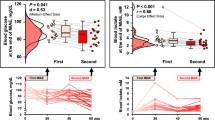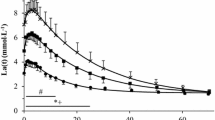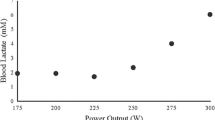Summary
Seven trained male cyclists (\(\dot V_{O_{2max} } \)=4.42±0.23 l·min−1; weight 71.7±2.7 kg, mean ± SE) completed two incremental cycling tests on the cycle ergometer for the estimation of the “individual anaerobic threshold” (IAT). The cyclists completed three more exercises in which the work rate incremented by the same protocol, but upon reaching selected work rates of approximately 40, 60 and 80%\(\dot V_{O_{2max} } \), the subjects cycled for 60 min or until exhaustion. In these constant load studies, blood lactate concentration was determined on arterialized venous ([La−]av) and deep venous blood ([La−]v) of the resting forearm. The av-v lactate gradient across the inactive forearm muscle was −0.08 mmol·l−1 at rest. After 3 min at each of the constant load work rates, the gradients were +0.05, +0.65* and +1.60* mmol·l−1 (*P<0.05). The gradients after 10 min at these same work rates were −0.09, +0.24 and +1.03* mmol·l−1. For the two highest work rates taken together, the lactate gradient was less at 10 min than 3 min constant load exercise (P<0.05). The [La−]av was consistently higher during prolonged exercise at both 60 and 80%\(\dot V_{O_{2max} } \) than that observed at the same work rate during progressive exercise. At the highest work rate (at or above the IAT), time to exhaustion ranged from 3 to 36 min in the different subjects. These data showed that [La−] uptake across resting muscle continued to increase to work rates above the IAT. Further, the greater av-v lactate gradient at 3 min than 10 min constant load exercise supports the concept that inactive muscle might act as a passive sink for lactate in addition to a metabolic site.
Similar content being viewed by others
References
Ahlborg G, Felig P (1982) Lactate and glucose exchange across the forearm, legs, and splanchnic bed during and after prolonged leg exercise. J Clin Invest 69:45–54
Ahlborg G, Hagenfeldt L, Wahren J (1975) Substrate utilization by the inactive leg during one-leg or arm exercise. J Appl Physiol 39:718–723
Anderson SJ, Hughson RL, Sherrill DL, Swanson GD (1986) Determination of the “anaerobic threshold”. J Appl Physiol 60:2135–2137
Bang O (1936) The lactate content of blood during and after muscular exercise in man. Scand Arch Physiol 74 [Suppl 10]:51–82
Belcastro AN, Bonen A (1975) Lactic acid removal rates during controlled and uncontrolled recovery exercise. J Appl Physiol 39:932–936
Brooks GA (1985) Anaerobic threshold: review of the concept and directions for future research. Med Sci Sports Exerc 17:22–31
Forster HV, Dempsey JA, Thomson J, Vidruk E, DoPico GA (1972) Estimation of arterial PO2, PCO2, pH and lactate from arterialized venous blood. J Appl Physiol 32:134–137
Freund H, Zouloumian P (1981) Lactate after exercise in man. I. Evolution kinetics in arterial blood. Eur J Appl Physiol 46:121–133
Green HJ, Hughson RL, Orr GW, Ranney DA (1983) Anaerobic threshold, blood lactate and muscle metabolites in progressive exercise. J Appl Physiol 54:1031–1038
Heck H, Mader A, Hess G, Mucke S, Muller R, Hollmann W (1985) Justification of the 4-mmol/l lactate threshold. Int J Sports Med 6:117–130
Hughson RL, Weisiger KH, Swanson GD (1987) Blood lactate concentration increases as a continuous function in progressive exercise. J Appl Physiol 62:1975–1981
Hughson RL, Sherrill DL, Swanson GD (1988) Kinetics of VO2 with impulse and step exercise in man. J Appl Physiol 64:451–459
Johnson JA, Fusaro RM (1972) The role of the skin in carbohydrate metabolism. In: Levine R, Luft R (eds) Advances in metabolic disorders, vol 6. Academic Press, New York, pp 2–55
Jorfeldt L, Juhlin-Dannfelt A, Karlsson J (1978) Lactate release in relation to tissue lactate in human skeletal muscle during exercise. J Appl Physiol 44:350–352
Karlsson J, Jacobs I (1982) Onset of blood lactate accumulation during muscular exercise as a threshold concept. I. Theoretical consideration. Int J Sports Med 3:190–201
Katz J (1982) Importance of sites of tracer administration and sampling in turnover studies. Fed Proc 41:123–128
Lowry OH, Passonneau JV (1972) A flexible system of enzymatic analysis. Worth, New York, pp 151–153
Poortmans JR, Delescaille-VandenBossche J, Leclercq R (1978) Lactate uptake by inactive forearm during progressive exercise. J Appl Physiol 45:835–839
Sahlin K (1987) Lactate production cannot be measured with tracer techniques. Am J Physiol 252:E439-E440
Stanley WC, Gertz EW, Wisneski JA, Neese RA, Morris DL, Brooks GA (1986) Lactate extraction during net lactate release in legs of humans during exercise. J Appl Physiol 60:1116–1120
Stanley WC, Wisneski JA, Gertz EW, Neese RA, Brooks GA (1988) Glucose and lactate interrelations during moderate-intensity exercise in humans. Metabolism 37:850–858
Stegmann H, Kinderman W, Schnabel A (1981) Lactate kinetics and individual anaerobic threshold. Int J Sports Med 2:160–165
Stegmann H, Kinderman W (1982) Comparison of prolonged exercise tests at the individual anaerobic threshold and the fixed anaerobic threshold of 4 mmol/l lactate. Int J Sports Med 3:105–110
Wasserman K, Whipp BJ, Koyal SN, Beaver WL (1973) Anaerobic threshold and respiratory gas exchange during exercise. J Appl Physiol 35:236–243
Author information
Authors and Affiliations
Rights and permissions
About this article
Cite this article
Orok, C.J., Hughson, R.L., Green, H.J. et al. Blood lactate responses in incremental exercise as predictors of constant load performance. Europ. J. Appl. Physiol. 59, 262–267 (1989). https://doi.org/10.1007/BF02388326
Accepted:
Issue Date:
DOI: https://doi.org/10.1007/BF02388326




